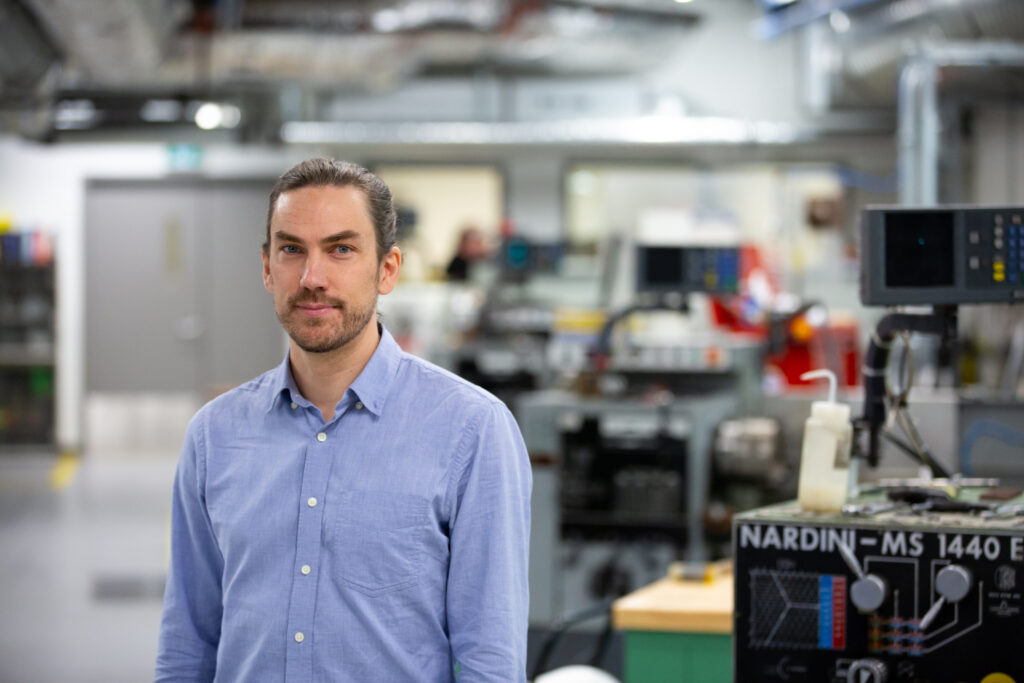Written by Jennifer Myers BA’97
Antimatter: It’s possibly the greatest mystery in the universe. Dr. Timothy Friesen, MSc’07, PhD’14, is helping to build our understanding of the true nature of antimatter and its behaviour.
The knowledge he and colleagues are uncovering is foundational for a complete picture of the quantum world and also holds promise for heightened development of quantum science and the technologies that are already reshaping our lives.
Quantum has become more than science; it is a burgeoning economic sector, backed by Canada’s National Quantum Strategy including research that is expected to fuel new technologies primed for commercialization, medical advances, and even climate forecasting and business operations.
But none of that happens without building our knowledge of the tiniest things. It’s one of the ways scientists are seeking to understand quantum science, a field which the National Quantum Strategy describes as seeking to predict and explain the behaviour of atoms and molecules and involves the manipulation and control of systems at the atomic and subatomic levels.
It’s admittedly complicated for the non-physicists among us, but here Friesen breaks down the basics on the science of antimatter and how quantum physics is sleuthing for answers.
Antimatter Mirrors Matter
For every set of particles of matter, there is a set of particles that mirror them. We call those antimatter. The only known difference between matter and antimatter is they have the opposite charge.
Remember your protons and electrons?
“Matter particle protons have a positive charge and electrons have a negative charge,” says Friesen, professor of physics and astronomy in the University of Calgary’s Faculty of Science. “An antiproton looks like a proton, but it has a negative electrical charge. An anti-electron, sometimes called a positron, has a positive electric charge. So, antimatter is simply this other particle that exists with the opposite charge but otherwise looks the same — same mass and same way of interacting.”

It’s One of the Greatest Scientific Mysteries
While the mirroring of matter and antimatter might make you think there are equal amounts of each in the universe, that isn’t the case. But physicists don’t know why.
“If I want to turn energy into matter, I have to create pairs of matter and antimatter particles,” says Friesen. “So then, if we extrapolate back to the beginning of the universe, we would expect that the Big Bang would have produced one antimatter particle for every matter particle at the start. And then you would expect to see equal amounts of matter and antimatter out in the universe.”
“The problem is, when we look out at everything around us, we do not see any large amount of antimatter out there. There are no antimatter stars that we can see, no antimatter galaxies.”
Miniscule Amounts of Antimatter Do Exist in Nature
Despite a significant lack of antimatter compared to the matter all around us, Friesen says we can detect antimatter particles occurring in nature, in a minute form. When some atoms decay, turning into other kinds of atom, they emit the anti-version of an electron, or, in other words, a positron.
Let’s take bananas.
“There’s a tiny amount of radioactive potassium in bananas,” says Friesen. “That radioactive potassium is always slowly decaying and emitting antimatter. Any grocery store banana is actually emitting antimatter all of the time. We’ve observed antielectrons and antiprotons in the lab and in in other kinds of interactions that happen in nature. So, we know that these particles can and do exist.”
Tiny Explosions
How do scientists know those bananas are emitting antimatter? That decay presents itself as tiny explosions.
When matter and antimatter meet, they turn into photons and other energetic particles, rather than still existing as particles. Physicists call this annihilation. In a sense, it’s a very, very, very, very, very, very tiny explosion of the nucleus. Because it’s so tiny, don’t worry about your banana split taking out the Dairy Queen.
Of course, if you had lots of each, you would get a big explosion and both the matter and antimatter would disappear.
Scientists Can Harness Antimatter in the Lab
In fact, it’s this annihilation that allows scientists to detect and observe the antimatter.
“It’s very difficult for us to make and see antimatter atoms and so one of the ways we can detect that we have them is we allow them to hit matter,” says Friesen. “Then, the explosion produces characteristic decay products and those will fly through our detector.”
Imagine pixels in a charged-coupled device (CCD) camera, which manipulates an electrical signal into a digital output. If one of these decay particles flies through it, that a little pixel would light up. Observing that small amount of energy is what tells Friesen the antimatter had been there.
Part of Friesen’s work is making the antimatter versions of antiprotons and antielectrons in the lab and then combining them to make antihydrogen atoms. Because antimatter doesn’t occur in the universe in a stable form, manufacturing antihydrogen allows he and his colleagues to synthesize and study them in the lab.
Antimatter Falls Downward

Friesen, along with fellow physics professor Dr. Robert Thompson, PhD, led UCalgary’s research participation in the ALPHA (Antihydrogen Laser PHysics Apparatus) experiment at CERN, the European Organization for Nuclear Research, where the team looked at how antimatter behaves in gravity. They built and installed an antimatter trap known as ALPHA-g to confine the antihydrogen created in the lab. Here, they could observe it in a gravity environment. As predicted, the antimatter fell downward, just like matter.
Next, Friesen and his colleagues are seeking to learn if antimatter absorbs light and radiation at the same wavelengths as matter. These experiments help them to understand the larger question: is antimatter truly identical to matter, or are there ways in which it is different?
Antimatter is Used in Some Medical Technologies
The medical imaging used in PET (Positron Emission Tomography) scans use antimatter in the form of positrons to detect the presence of diseases like cancer or other conditions in the body. A radioactive dye injection emits positrons that undergo annihilation when they meet electrons in the body and give a characteristic signal that can be detected by the scanner.
Creators of science fiction have imagined uses for antimatter such as employing it as an energy source for spacecraft. But presently, there is still so much to learn about antimatter and producing it is so difficult that real-world applications are currently limited.
Find out more about what’s happening with quantum research at UCalgary! Join us Feb. 21 for our inaugural event in the Creating Tomorrow series where we will explore the fascinating world of quantum research and discover how it will impact our daily lives. Learn more and register now.




